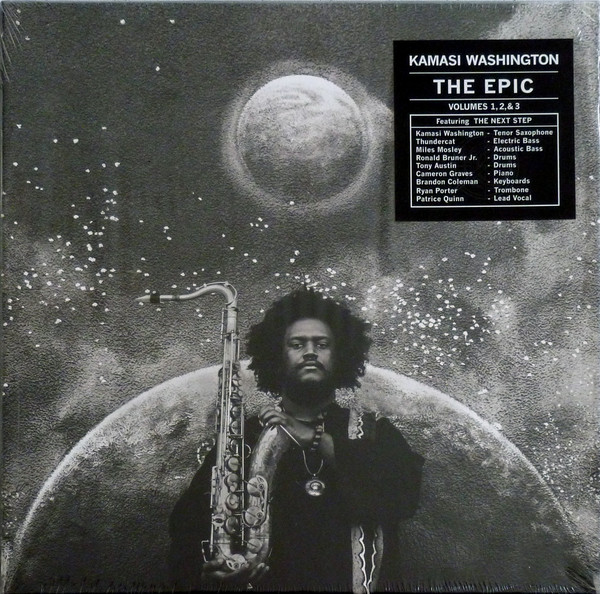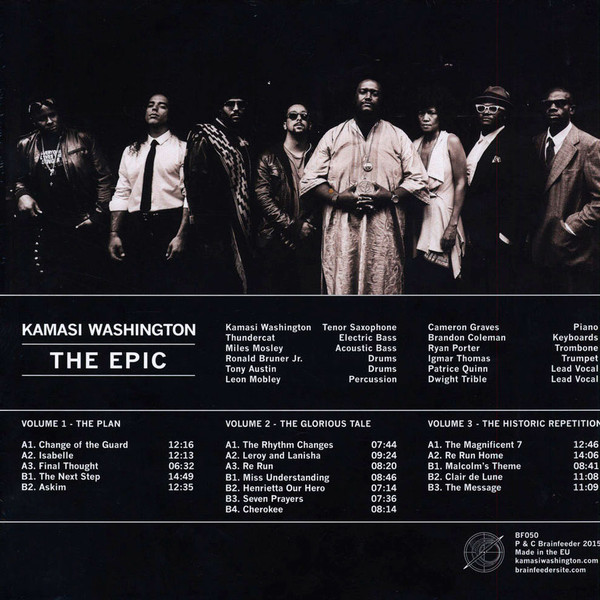Life began for Kamasi Washington on February 18, 1981 in Los Angeles, California. In the Washington family music was more of a prerequisite than a privilege. But Kamasi never saw it that way, his love for music began at first sound. His father, Rickey Washington is a professional saxophonist by night and a high school music teacher by day. Kamasi’s mother, Valerie Washington is an accomplished flutist who fell in love with the world of science and became a high school chemistry teacher after her stint as a genetic researcher. By the age of two Kamasi had already began to play the drums and piano, the only thing that kept him away from the wind instruments at that early age was his lack of dental development. He began his exploration into the world of the reeds and brass when he was about seven and his father gave him a clarinet. By the age of twelve Kamasi had found his voice in the form of a tenor saxophone, in fact it was the same saxophone that his father played in high school.
Over the next year Kamasi’s development and devotion to music had out grown his academic environment. So he transferred from The Los Angeles Center of Enriched Studies (one the top academic high schools in the nation) and enrolled into the Hamilton High School Music Academy. It was around this time that Kamasi also joined The Multi School Jazz Band (M.S.J.B.), an assembly of the finest young jazz musicians in Los Angeles County and led by Reginald Andrews the same man that taught Kamasi’s father in high school. Because of the sheer vastness of talent that he was surrounded by it was in The Multi School Jazz Band that Kamasi was most inspired during his high school years. Through M.S.J.B. Kamasi was also able to meet, learn, and create relationships with many of his musical idols such as Wayne Shorter, Herbie Hancock, Horse Tapscot, Gerald Wilson, and many others. In Kamasi’s senior year of high school he had the opportunity to compete in the John Coltrane Saxophone competition, in which he received the first place award. As an additional benefit to winning the competition the band of M.S.J.B. members that he assembled to accompany him had such an immediate connection that they decided to stay together and form a group that soon after would be known as “The Young Jazz Giants”.
This fiery group of “Young Giants” wasted no time in spreading their musical wings and flying all over the Los Angeles jazz scene spreading the good news that jazz was still alive and in very good hands. It was during this time that Kamasi became interested in composition and he started writing his own music. Over the next year “The Young Jazz Giants” had really began to develop their own sound and were creating a lot of excitement in their community.
After graduating from high school Kamasi began his studies at U.C.L.A. were the facility included some of the finest musicians in the history of Jazz, such as Kenny Burrell, Billy Higgins, Harold Land, Lew Mathews, Garnett Brown, Jeff Clayton, Gerald Wilson, and many others. By the end of his first year at U.C.L.A. Kamasi began performing with many of his professors. In fact he joined Gerald Wilson’s big band and later became the only member of his regular Los Angeles band to be invited to play on his latest album “In My Time” which was recorded in New York. During the summer after Kamasi’s first year at U.C.L.A. the head of a new record label called “Bird Man Records” heard him playing with “The Young Jazz Giants” and became very interested in making an album with the group. So Kamasi recorded his first album it was called The Young Jazz Giants. The completion of the album seemed like the “big break” for “The Young Jazz Giants” but unforeseen delays in the products release ended in the album being released almost two years after its completion. Ironically the talent level of the group was far too high for any of the members of the band to stay “ready and waiting” for too long, thus “The Young Jazz Giants” unofficially disbanded.
Kamasi began to take interest and became influenced by many other forms of music, from European Classical to Hip Hop. This really opened his mind to the fact that all of the different forms that music takes are equally relevant. From this Kamasi ended up playing with many of the most legendary musicians of the current variety such as Snoop Dog, Raphael Saadiq, and many others. Yet during this time Kamasi despite his newfound respect for all of the forms of music realized that Jazz was still the music that was closest to his heart. So he started a new band that would be able to play the new music that he is creating. The new group is called “The Next Step” and that’s precisely what Kamasi intends on taking.
(2) Kamasi Washington didn't pick up a saxophone until he was 13 years old, but by that point, he'd been playing several other instruments. That's when he found his calling. Within a couple years, he was the lead tenor saxophonist at Hamilton High School Music Academy in his native Los Angeles. After graduation, he attended UCLA to study ethnomusicology. While enrolled at UCLA, he recorded a self-titled album with Young Jazz Giants, a quartet he had formed with Cameron Graves and brothers Ronald Bruner, Jr. and Stephen "Thundercat" Bruner, released in 2004. From that point, Washington continually performed and recorded with an impressive variety of major artists across several genres, including Snoop Dogg, Raphael Saadiq, Gerald Wilson, McCoy Tyner, George Duke, and PJ Morton. In 2014 alone, Washington demonstrated tremendous range with appearances on Broken Bells' After the Disco, Harvey Mason's Chameleon, Stanley Clarke's Up, and Flying Lotus' You're Dead!, among other albums that covered indie rock, contemporary and progressive jazz, and experimental electronic music.
The following year, Washington contributed to Kendrick Lamar's To Pimp a Butterfly and finally debuted as a leader with The Epic, released on Flying Lotus' Brainfeeder label. An expansive triple album nearly three hours in duration, it involved the other three-quarters of Young Jazz Giants -- by then part of his larger ten piece collective, altnerately known as The Next Step and West Coast Get Down-- string orchestra and choir conducted by Miguel Atwood-Ferguson.
The Epic was a critical and commerial success. Not only did it land at number three on the jazz charts, it also found its way on to independent albums and heatseekers charts as well. Washington and his band were not only able to tour the U.S., but to play in Europe and Japan as well. ~ Andy Kellman
Read more on Last.fm. User-contributed text is available under the Creative Commons By-SA License; additional terms may apply.


